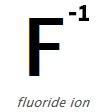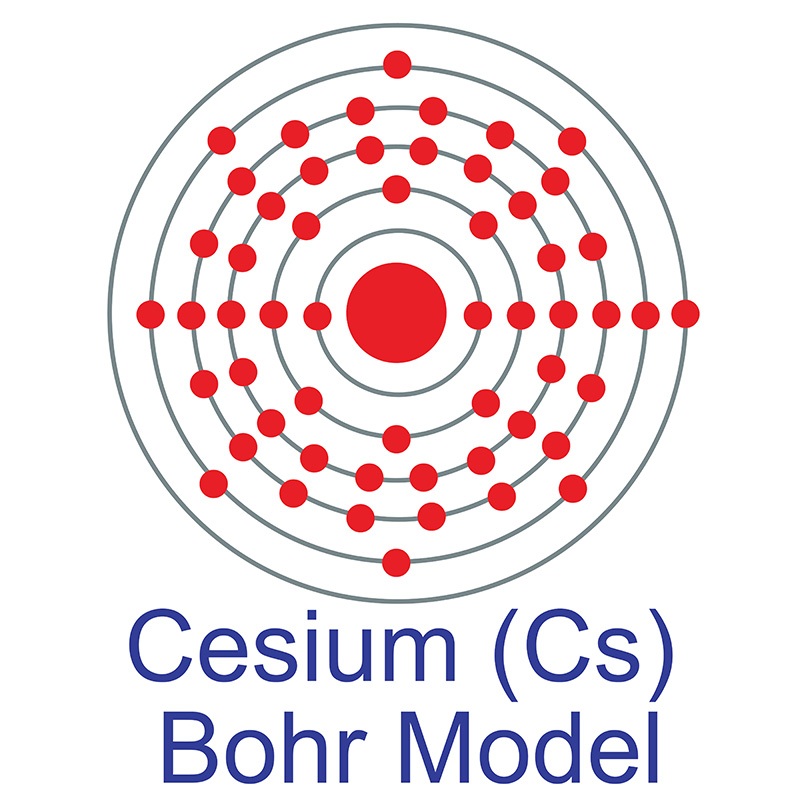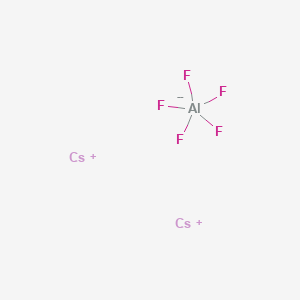SECTION 1. IDENTIFICATION
Product Name: Cesium Fluoroaluminate
Product Number: All applicable American Elements product codes, e.g. CS-FAL-02
, CS-FAL-03
, CS-FAL-04
, CS-FAL-05
CAS #: 138577-01-2
Relevant identified uses of the substance: Scientific research and development
Supplier details:
American Elements
10884 Weyburn Ave.
Los Angeles, CA 90024
Tel: +1 310-208-0551
Fax: +1 310-208-0351
Emergency telephone number:
Domestic, North America: +1 800-424-9300
International: +1 703-527-3887
SECTION 2. HAZARDS IDENTIFICATION
Classification of the substance or mixture
GHS Classification in accordance with 29 CFR 1910 (OSHA HCS)
Acute toxicity, Oral(Category 3), H301
Skin corrosion(Category 1B), H314
Serious eye damage(Category 1), H318
GHS Label elements, including precautionary statements
Pictogram


Signal word
Danger
Hazard statement(s)
H301
Toxic if swallowed.
H314
Causes severe skin burns and eye damage.
Precautionary statement(s)
P260
Do not breathe dust or mist.
P264
Wash skin thoroughly after handling.
P270
Do not eat, drink or smoke when using this product.
P280
Wear protective gloves/ protective clothing/ eye protection/ face protection.
P301 + P310
IF SWALLOWED: Immediately call a POISON CENTER/doctor.
P301 + P
330 + P331
IF SWALLOWED: Rinse mouth. Do NOT induce vomiting.
P303 + P361 + P353
IF ON SKIN (or hair): Remove/ Take off immediately all contaminated clothing. Rinse skin with water/ shower.
P304 + P340
IF INHALED: Remove victim to fresh air and keep at rest in a position comfortable for breathing.
P305 + P351 + P338
IF IN EYES: Rinse cautiously with water for several minutes. Remove contact lenses, if present and easy to do. Continue rinsing.
P310
Immediately call a POISON CENTER/doctor.
P321
Specific treatment (see supplemental first aid instructions on this label).
P363
Wash contaminated clothing before reuse.
P405
Store locked up.
P501
Dispose of contents/ container to an approved waste disposal plant.
Hazards not otherwise classified (HNOC) or not covered by GHS
Weak hydrogen fluoride-releaser
SECTION 3. COMPOSITION/INFORMATION ON INGREDIENTS
Substances
Formula: AlCs2F5
Molecular weight: 387.78 g/mol
CAS-No.: 138577-01-2
SECTION 4. FIRST AID MEASURES
Description of first aid measures
General advice
Consult a physician. Show this safety data sheet to the doctor in attendance.
Move out of dangerous area.
Hydrofluoric (HF) acid burns require immediate and specialized first aid and medical treatment. Symptoms may be delayed up to 24 hours depending on the concentration of HF. After decontamination with water, further damage can occur due to penetration/absorption of the fluoride ion. Treatment should be directed toward binding the fluoride ion as well as the effects of exposure. Skin exposures can be treated with a 2.5% calcium gluconate gel repeated until burning ceases.
More serious skin exposures may require subcutaneous calcium gluconate except for digital areas unless the physician is experienced in this technique, due to the potential for tissue injury from increased pressure. Absorption can readily occur through the subungual areas and should be considered when undergoing decontamination. Prevention of absorption of the fluoride ion in cases of ingestion can be obtained by giving milk, chewable calcium carbonate tablets or Milk of Magnesia to conscious victims. Conditions such as hypocalcemia, hypomagnesemia and cardiac arrhythmias should be monitored for, since they can occur after exposure.
If inhaled
If breathed in, move person into fresh air. If not breathing, give artificial respiration. Consult a physician.
In case of skin contact
Take off contaminated clothing and shoes immediately. Wash off with soap and plenty of water. Take victim immediately to hospital. Consult a physician.
First treatment with calcium gluconate paste.
In case of eye contact
Rinse thoroughly with plenty of water for at least 15 minutes and consult a physician.
Continue rinsing eyes during transport to hospital.
If swallowed
Do NOT induce vomiting. Never give anything by mouth to an unconscious person. Rinse mouth with water. Consult a physician.
Most important symptoms and effects, both acute and delayed
The most important known symptoms and effects are described in the labelling (see section 2) and/or in section 11
Indication of any immediate medical attention and special treatment needed
No data available
SECTION 5. FIREFIGHTING MEASURES
Extinguishing media
Suitable extinguishing media
Use water spray, alcohol-resistant foam, dry chemical or carbon dioxide.
Special hazards arising from the substance or mixture
No data available
Advice for firefighters
Wear self-contained breathing apparatus for firefighting if necessary.
Further information
No data available
SECTION 6. ACCIDENTAL RELEASE MEASURES
Personal precautions, protective equipment and emergency procedures
Wear respiratory protection. Avoid dust formation. Avoid breathing Vapors, mist or gas. Ensure
adequate ventilation.
Evacuate personnel to safe areas. Avoid breathing dust.
For personal protection see section 8.
Environmental precautions
Prevent further leakage or spillage if safe to do so. Do not let product enter drains.
Methods and materials for containment and cleaning up
Pick up and arrange disposal without creating dust. Sweep up and shovel. Keep in suitable, closed containers for disposal.
Reference to other sections
For disposal see section 13.
SECTION 7. HANDLING AND STORAGE
Precautions for safe handling
Avoid contact with skin and eyes. Avoid formation of dust and aerosols.
Provide appropriate exhaust ventilation at places where dust is formed.
For precautions see section 2.
Conditions for safe storage, including any incompatibilities
Keep container tightly closed in a dry and well-ventilated place.
Specific end use(s)
Apart from the uses mentioned in section 1 no other specific uses are stipulated
SECTION 8. EXPOSURE CONTROLS/PERSONAL PROTECTION
Exposure controls
Appropriate engineering controls
Avoid contact with skin, eyes and clothing. Wash hands before breaks and immediately after handling the product.
Personal protective equipment
Eye/face protection
Face shield and safety glasses Use equipment for eye protection tested and approved under appropriate government standards such as NIOSH (US) or EN 166(EU).
Skin protection
Handle with gloves. Gloves must be inspected prior to use. Use proper glove removal technique (without touching glove's outer surface) to avoid skin contact with this product.
Dispose of contaminated gloves after use in accordance with applicable laws and good laboratory practices. Wash and dry hands.
Body Protection
Complete suit protecting against chemicals, The type of protective equipment must be selected according to the concentration and amount of the dangerous substance at the specific workplace.
Respiratory protection
Where risk assessment shows air-purifying respirators are appropriate use a full-face particle respirator type N100 (US) or type P3 (EN 143) respirator cartridges as a backup to engineering controls. If the respirator is the sole means of protection, use a full-face supplied air respirator. Use respirators and components tested and approved under appropriate government standards such as NIOSH (US) or CEN (EU).
Control of environmental exposure
Prevent further leakage or spillage if safe to do so. Do not let product enter drains.
SECTION 9. PHYSICAL AND CHEMICAL PROPERTIES
Information on basic physical and chemical properties
Appearance
Form: solid
Odor
No data available
Odor Threshold
No data available
pH
No data available
Melting point/freezing point
Melting point/range: 423 -436 °C (793 -817 °F)
Initial boiling point and boiling range
No data available
Flash point
N/A
Evaporation rate
No data available
Flammability (solid, gas)
No data available
Upper/lower flammability or explosive limits
No data available
Vapor pressure
No data available
Vapor density
No data available
Relative density
3.700 g/cm3
Water solubility
No data available
Partition coefficient: n-octanol/water
No data available
Auto-ignition temperature
No data available
Decomposition temperature
No data available
Viscosity
No data available
Explosive properties
No data available
Oxidizing properties
No data available
Other safety information
No data available
SECTION 10. STABILITY AND REACTIVITY
Reactivity
No data available
Chemical stability
Stable under recommended storage conditions.
Possibility of hazardous reactions
No data available
Conditions to avoid
No data available
Incompatible materials
Strong oxidizing agents, Sulfuric acid, Nitric acid
Hazardous decomposition products
Hazardous decomposition products formed under fire conditions.-Hydrogen fluoride, Hydrogen iodide, Cesium/cesium oxides
Other decomposition products-No data available
In the event of fire: see section 5
SECTION 11. TOXICOLOGICAL INFORMATION
Information on toxicological effects
Acute toxicity
No data available
Inhalation: No data available
Dermal: No data available
No data available
Skin corrosion/irritation
No data available
Serious eye damage/eye irritation
No data available
Respiratory or skin sensitisation
No data available
Germ cell mutagenicity
No data available
Carcinogenicity
IARC:
No component of this product present at levels greater than or equal to 0.1% is identified as
probable, possible or confirmed human carcinogen by IARC.
NTP:
No component of this product present at levels greater than or equal to 0.1% is identified
as a known or anticipated carcinogen by NTP.
OSHA:
No component of this product present at levels greater than or equal to 0.1% is identified as a
carcinogen or potential carcinogen by OSHA.
Reproductive toxicity
No data available
No data available
Specific target organ toxicity -single exposure
No data available
Specific target organ toxicity -repeated exposure
No data available
Aspiration hazard
No data available
Additional Information
RTECS: Not available
Fluoride ion can reduce serum calcium levels possibly causing fatal hypocalcemia.
Cough, Shortness of breath, Headache, Nausea, Vomiting
Stomach-Irregularities-Based on Human Evidence
Stomach-Irregularities-Based on Human Evidence
SECTION 12. ECOLOGICAL INFORMATION
Toxicity
No data available
Persistence and degradability
No data available
Bioaccumulative potential
No data available
Mobility in soil
No data available
Results of PBT and vPvB assessment
PBT/vPvB assessment not available as chemical safety assessment not required/not conducted
Other adverse effects
No data available
SECTION 13. DISPOSAL CONSIDERATIONS
Waste treatment methods
Product
Offer surplus and non-recyclable solutions to a licensed disposal company.
Contact a licensed professional waste disposal service to dispose of this material.
Dissolve or mix the material with a combustible solvent and burn in a chemical incinerator equipped with an afterburner and scrubber.
Contaminated packaging
Dispose of as unused product.
SECTION 14. TRANSPORT INFORMATION
"UN-Number
DOT, ADN, IMDG, IATA
N/A
UN proper shipping name
DOT, ADN, IMDG, IATA
N/A
Transport hazard class(es)
DOT, ADR, ADN, IMDG, IATA
Class
N/A
Packing group
DOT, IMDG, IATA
N/A
Environmental hazards:
N/A
Special precautions for user
N/A
Transport in bulk according to Annex II of MARPOL73/78 and the IBC Code
N/A
Transport/Additional information:
DOT
Marine Pollutant (DOT):
No
SECTION 15. REGULATORY INFORMATION
Safety, health and environmental regulations/legislation specific for the substance or mixture
GHS label elements
The product is classified and labeled in accordance with 29 CFR 1910 (OSHA HCS)
Hazard pictograms
GHS07
Signal word
Warning
Hazard statements
H302 Harmful if swallowed.
H315 Causes skin irritation.
H319 Causes serious eye irritation.
H335 May cause respiratory irritation.
Precautionary statements
P261
Avoid breathing dust/fume/gas/mist/vapors/spray.
P280
Wear protective gloves/protective clothing/eye protection/face protection.
P305+P351+P338 IF IN EYES: Rinse cautiously with water for several minutes. Remove contact lenses, if present and easy to do. Continue rinsing.
P304+P340
IF INHALED: Remove person to fresh air and keep comfortable for breathing.
P405
Store locked up.
P501
Dispose of contents/container in accordance with local/regional/national/international regulations.
National regulations
All components of this product are listed in the U.S. Environmental Protection Agency Toxic Substances Control Act Chemical substance Inventory.
All components of this product are listed on the Canadian Non-Domestic Substances List (NDSL).
SARA Section 313 (specific toxic chemical listings)
Substance is not listed.
California Proposition 65
Prop 65 - Chemicals known to cause cancer
Substance is not listed.
Prop 65 - Developmental toxicity
Substance is not listed.
Prop 65 - Developmental toxicity, female
Substance is not listed.
Prop 65 - Developmental toxicity, male
Substance is not listed.
Information about limitation of use:
For use only by technically qualified individuals.
Other regulations, limitations and prohibitive regulations
Substance of Very High Concern (SVHC) according to the REACH Regulations (EC) No. 1907/2006.
Substance is not listed.
The conditions of restrictions according to Article 67 and Annex XVII of the Regulation (EC) No 1907/2006 (REACH) for the manufacturing, placing on the market and use must be observed.
Substance is not listed.
Annex XIV of the REACH Regulations (requiring Authorisation for use)
Substance is not listed.
Chemical safety assessment:
A Chemical Safety Assessment has not been carried out.
SECTION 16. OTHER INFORMATION
Safety Data Sheet according to Regulation (EC) No. 1907/2006 (REACH). The above information is believed to be correct but does not purport to be all inclusive and shall be used only as a guide. The information in this document is based on the present state of our knowledge and is applicable to the product with regard to appropriate safety precautions. It does not represent any guarantee of the properties of the product. American Elements shall not be held liable for any damage resulting from handling or from contact with the above product. See reverse side of invoice or packing slip for additional terms and conditions of sale. COPYRIGHT 1997-2022 AMERICAN ELEMENTS. LICENSED GRANTED TO MAKE UNLIMITED PAPER COPIES FOR INTERNAL USE ONLY.

 Aluminum's name is derived from alumina, the mineral from which Sir Humphrey Davy attempted to refine it from in 1812. Aluminum was first predicted by Antoine Lavoisier 1787 and first isolated by Hans Christian Øersted in 1825. Aluminum is a silvery gray metal that possesses many desirable characteristics. It is light, nonmagnetic and non-sparking. It stands second among
Aluminum's name is derived from alumina, the mineral from which Sir Humphrey Davy attempted to refine it from in 1812. Aluminum was first predicted by Antoine Lavoisier 1787 and first isolated by Hans Christian Øersted in 1825. Aluminum is a silvery gray metal that possesses many desirable characteristics. It is light, nonmagnetic and non-sparking. It stands second among  Although it has only 60% of the electrical conductivity of
Although it has only 60% of the electrical conductivity of  The cesium atom has a radius of 265 pm and a Van der Waals radius of 343 pm. Cesium is a member of the alkali group of
The cesium atom has a radius of 265 pm and a Van der Waals radius of 343 pm. Cesium is a member of the alkali group of  Cesium's main commercial source is pollucite ore; however, it is also found in beryl, avogadrite, pezzottaite, and londonite. Cesium was discovered by Robert Bunsen and Gustav Kirchhoff in 1860 and first isolated by Carl Setterberg in 1882. In its elemental form, cesium has a silvery gold appearance. The word Cesium originates from the Latin word "caesius," meaning "sky blue," which refers to the vibrant blue lines in its spectrum.
Cesium's main commercial source is pollucite ore; however, it is also found in beryl, avogadrite, pezzottaite, and londonite. Cesium was discovered by Robert Bunsen and Gustav Kirchhoff in 1860 and first isolated by Carl Setterberg in 1882. In its elemental form, cesium has a silvery gold appearance. The word Cesium originates from the Latin word "caesius," meaning "sky blue," which refers to the vibrant blue lines in its spectrum.
